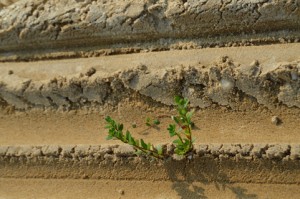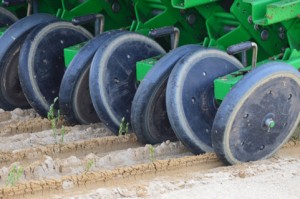Our 2015 bog reno is done and for the grand finale, our team finished with the inaugural planting of the new Rutgers Haines variety!
From Integrity Propagation’s April release:
The Haines™ Cranberry Variety…resulted from a 1999 cross between the Crimson Queen® variety as the seed parent and #35 as the pollen parent. The #35 variety is an unpatented variety from a ‘Howes x Searles’ cross from the 1940s USDA/NJAES Cranberry Breeding Program. Haines variety was one of 138 progeny of this 1999 cross, made at the Philip E. Marucci Center for Cranberry Research in Chatsworth, NJ. Haines variety was initially selected for its very high yield potential, mid-season ripening, large round berry (averaging about two grams per berry) and uniform fruit color. In 2007, the Haines variety was selected for further testing in advanced replication selection trials in Oregon, Washington, and Wisconsin. The plots continued to exhibit the variety’s consistent high yields with mid-season ripening. Haines has also exhibited less fruit rot than Stevens in these plots.
“We’re putting Haines in on a ten acre bog, but since it’s a new variety, stock is still low, so we ended up planting 8 acres and will finish in spring,” explains New Production Manager Mike Haines. “Those eight acres only took two days, with an average of 4.25 acres a day. That’s really good. And we did it with no late nights; we worked from 7 to 5:30 and our numbers were up from the previous record of 3.5 acres/day.” When asked why, he says, “There are lots of reasons. Every year, there are mistakes you learn from. That’s one improvement. The land is well cleared; there were no stumps that can cause a momentary halting of the process. We concentrated on having both planters make the longest passes possible through the bed, which means we have to make fewer turns, which increases our efficiency.”
Planting a new variety is not without its challenges! “We finished up with hand planting, and I was pretty nervous about going back and forth between the Haines bog and the Mullica Queens,” Mike says. “Making sure we didn’t create any inadvertent hybrids was a little nerve-wracking!” He is hopeful for the expected higher yields and increased rot resistance, as well: “If you have your name on it, you especially want to get good results.”
*Photo credits, top and bottom photos: Nadine Haines.



